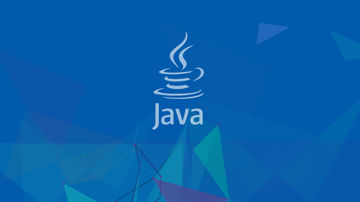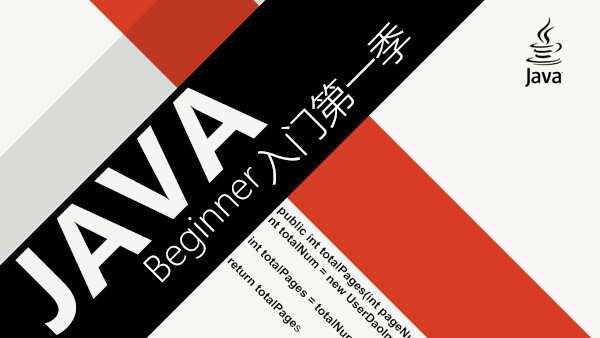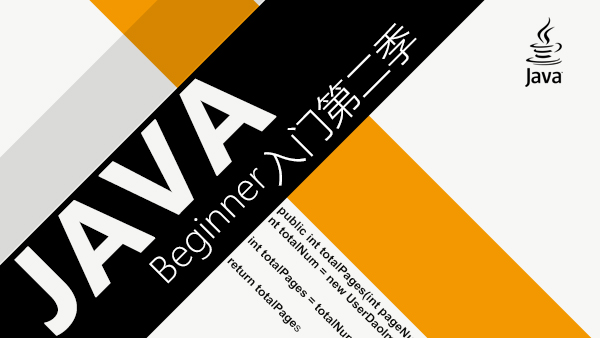本文提供了从安装到实践的全面指南,帮助新手学习JAVA主流技术。文章涵盖了Java的基础语法、面向对象编程、常用API与工具,以及Web开发入门等内容。通过示例代码和详细步骤,帮助读者逐步掌握Java的核心技能和应用场景。
Java简介与安装Java 是一种广泛使用的编程语言,它最初由 Sun Microsystems(现为 Oracle Corporation)开发。Java 设计的初衷是为了编写一次编译,到处运行(Write Once, Run Anywhere)的程序。Java 语言具有简单性、面向对象、健壮性、安全性等特性,使得它在企业应用、Web 开发、移动开发等多个领域得到广泛应用。
Java的安装
- 下载安装包:首先访问 Oracle 官方网站并下载 Java 的最新版本。选择适合您操作系统的版本进行下载。
- 安装Java:运行下载的安装程序,按照提示完成安装。
- 环境变量配置:安装完成后,需要配置系统的环境变量。对于 Windows 系统,可以设置
JAVA_HOME和PATH变量;对于 Linux 或 macOS,可以使用export命令设置环境变量。 - 验证安装:在命令行中输入
java -version,如果显示 Java 版本信息,则表示安装成功。
示例代码(验证Java安装):
java -version第一个Java程序
编写一个简单的 "Hello, World" 程序来开始学习 Java。这将帮助你熟悉 Java 的基本语法,并了解如何编译和运行 Java 程序。
步骤
- 创建文件:创建一个名为
HelloWorld.java的文件。 - 编写代码:在文件中编写以下代码:
public class HelloWorld {
public static void main(String[] args) {
System.out.println("Hello, World!");
}
}- 编译程序:使用
javac命令编译 Java 程序。
javac HelloWorld.java- 运行程序:使用
java命令运行编译后的类文件。
java HelloWorld输出结果:
Hello, World!Java开发环境搭建
开发环境通常包括代码编辑器、IDE(集成开发环境)和版本控制系统等。以下步骤介绍如何搭建 Java 开发环境。
创建一个简单的Java项目
- 选择代码编辑器:推荐使用 IntelliJ IDEA、Eclipse 或者 Visual Studio Code。
- 安装插件:安装必要的插件,如 Java 插件、Spring 插件等。
- 配置IDE:在 IDE 中配置 Java SDK 路径。
- 设置版本控制:推荐使用 Git 进行版本控制,可以从 GitHub 或者 GitLab 上克隆项目。
- 调试工具:使用内置的调试工具进行代码调试,设置断点、单步执行等。
示例代码(使用IDEA创建项目):
# 创建新项目
mvn archetype:generate -DgroupId=com.example -DartifactId=my-app -DarchetypeArtifactId=maven-archetype-quickstart -DinteractiveMode=false
# 进入项目文件夹
cd my-app
# 编译项目
mvn compileJava 的核心语法包括数据类型、变量、控制流程语句、方法与类等。掌握这些基础语法是编写高效 Java 程序的前提。
数据类型与变量
在 Java 中,数据类型分为两大类:基本数据类型和引用数据类型。基本数据类型包括 int、float、double、boolean 等,而引用数据类型则包括类、数组、接口等。
基本数据类型
int:整数类型,4 字节。float:单精度浮点数,4 字节。double:双精度浮点数,8 字节。boolean:布尔类型,只有true和false两个值。
变量声明
int age = 25;
float price = 19.99f;
double distance = 10.5;
boolean isStudent = true;控制流程语句
Java 提供了多种控制流程语句,包括条件语句、循环语句等。
条件语句
int number = 10;
if (number > 5) {
System.out.println("Number is greater than 5");
} else {
System.out.println("Number is less than or equal to 5");
}循环语句
for (int i = 0; i < 5; i++) {
System.out.println("Iteration: " + i);
}
int counter = 0;
while (counter < 5) {
System.out.println("Count: " + counter);
counter++;
}方法与类
Java 程序是由类组成的,类中可以包含方法和成员变量。方法可以是静态的(用 static 关键字修饰)或实例的(不使用 static 关键字修饰)。
方法
public class Calculator {
public int add(int a, int b) {
return a + b;
}
public static void main(String[] args) {
Calculator calc = new Calculator();
int result = calc.add(5, 3);
System.out.println("The result is: " + result);
}
}类
public class Person {
private String name;
private int age;
public Person(String name, int age) {
this.name = name;
this.age = age;
}
public String getName() {
return name;
}
public void setName(String name) {
this.name = name;
}
public int getAge() {
return age;
}
public void setAge(int age) {
this.age = age;
}
public void introduce() {
System.out.println("My name is " + name + " and I'm " + age + " years old.");
}
public static void main(String[] args) {
Person person = new Person("John", 25);
person.introduce();
}
}面向对象编程是 Java 的核心特性之一,它包括类、对象、继承、多态等概念。
类与对象
类是一组对象的抽象描述,对象是类的实例。类中包含属性(成员变量)和行为(方法)。
类的定义
public class Car {
private String model;
private int year;
public Car(String model, int year) {
this.model = model;
this.year = year;
}
public String getModel() {
return model;
}
public void setModel(String model) {
this.model = model;
}
public int getYear() {
return year;
}
public void setYear(int year) {
this.year = year;
}
public void drive() {
System.out.println("The car is driving.");
}
}对象的创建
public class Main {
public static void main(String[] args) {
Car myCar = new Car("Toyota Corolla", 2020);
myCar.drive();
}
}继承与多态
继承允许子类继承父类的属性和方法,而多态则使得一个对象能够表现出多种形态。
继承示例
public class Vehicle {
protected String brand;
protected int numberOfWheels;
public Vehicle(String brand, int numberOfWheels) {
this.brand = brand;
this.numberOfWheels = numberOfWheels;
}
public void move() {
System.out.println("The vehicle is moving.");
}
}
public class Car extends Vehicle {
public Car(String brand, int numberOfWheels) {
super(brand, numberOfWheels);
}
public void drive() {
System.out.println("The car is driving.");
}
}
public class Main {
public static void main(String[] args) {
Vehicle myVehicle = new Car("Toyota", 4);
myVehicle.move();
((Car) myVehicle).drive();
}
}多态示例
public class Main {
public static void main(String[] args) {
Vehicle vehicle = new Car("Toyota", 4);
vehicle.move(); // 输出: The vehicle is moving.
}
}接口与抽象类
接口定义了一组抽象方法,而抽象类则可以包含抽象方法和其他方法或成员变量。
接口
public interface Flyable {
void fly();
}
public class Bird implements Flyable {
@Override
public void fly() {
System.out.println("The bird is flying.");
}
}
public class Main {
public static void main(String[] args) {
Flyable bird = new Bird();
bird.fly();
}
}抽象类
public abstract class Animal {
public abstract void makeSound();
public void walk() {
System.out.println("The animal is walking.");
}
}
public class Cat extends Animal {
@Override
public void makeSound() {
System.out.println("Meow!");
}
}
public class Main {
public static void main(String[] args) {
Animal cat = new Cat();
cat.makeSound(); // 输出: Meow!
cat.walk();
}
}Java 提供了丰富的标准库 API,包括输入输出流、集合框架等。此外,还有一些常用的工具和库,如 Apache Commons、Log4j 等。
常用类库介绍
Java 标准库提供了大量的实用工具类,如 String 类、Math 类、Date 类等。
String 类
public class StringExample {
public static void main(String[] args) {
String str = "Hello, World!";
System.out.println(str.length()); // 输出: 13
System.out.println(str.charAt(0)); // 输出: H
System.out.println(str.toUpperCase()); // 输出: HELLO, WORLD!
}
}Math 类
public class MathExample {
public static void main(String[] args) {
System.out.println(Math.abs(-10)); // 输出: 10
System.out.println(Math.max(5, 10)); // 输出: 10
System.out.println(Math.random()); // 输出一个 0 到 1 之间的随机数
}
}Date 类
import java.util.Date;
public class DateExample {
public static void main(String[] args) {
Date currentDate = new Date();
System.out.println(currentDate); // 输出当前日期和时间
}
}输入输出流
Java 提供了 InputStream 和 OutputStream 类来处理输入输出操作。此外,还有 BufferedReader、BufferedWriter、FileReader、FileWriter 等类用于处理文件操作。
文件读取
import java.io.*;
public class FileReadExample {
public static void main(String[] args) {
try (BufferedReader reader = new BufferedReader(new FileReader("input.txt"))) {
String line;
while ((line = reader.readLine()) != null) {
System.out.println(line);
}
} catch (IOException e) {
e.printStackTrace();
}
}
}文件写入
import java.io.*;
public class FileWriteExample {
public static void main(String[] args) {
try (BufferedWriter writer = new BufferedWriter(new FileWriter("output.txt"))) {
writer.write("Hello, World!");
writer.newLine();
writer.write("This is a test.");
} catch (IOException e) {
e.printStackTrace();
}
}
}集合框架
Java 集合框架提供了一组用于存储和操作对象的接口和实现类。常用的接口包括 List、Set、Map,以及常用的实现类如 ArrayList、HashSet、HashMap 等。
使用ArrayList
import java.util.ArrayList;
public class ArrayListExample {
public static void main(String[] args) {
ArrayList<String> list = new ArrayList<>();
list.add("Apple");
list.add("Banana");
list.add("Cherry");
System.out.println(list); // 输出: [Apple, Banana, Cherry]
}
}使用HashMap
import java.util.HashMap;
public class HashMapExample {
public static void main(String[] args) {
HashMap<String, Integer> map = new HashMap<>();
map.put("Apple", 1);
map.put("Banana", 2);
map.put("Cherry", 3);
System.out.println(map); // 输出: {Apple=1, Banana=2, Cherry=3}
}
}Java Web 开发是 Java 技术的重要应用场景之一。常见的技术包括 Servlet、JSP、Spring 和 Spring Boot 等。
Servlet与JSP简介
Servlet 是 Java 开发 Web 应用的重要组件,它可以处理客户端请求并生成响应。JSP(JavaServer Pages)则是一种动态生成 Web 页面的技术,它可以在 HTML 中嵌入 Java 代码。
创建Servlet
import javax.servlet.*;
import javax.servlet.http.*;
import java.io.IOException;
public class HelloWorldServlet extends HttpServlet {
@Override
protected void doGet(HttpServletRequest request, HttpServletResponse response) throws ServletException, IOException {
response.setContentType("text/html");
response.getWriter().println("<h1>Hello, World!</h1>");
}
}创建JSP页面
<%@ page language="java" contentType="text/html; charset=UTF-8" pageEncoding="UTF-8"%>
<!DOCTYPE html>
<html>
<head>
<meta charset="UTF-8">
<title>My JSP Page</title>
</head>
<body>
<h1>Hello, JSP!</h1>
<p>Today's date: <%= new java.util.Date() %></p>
</body>
</html>JDBC数据库连接
Java 提供了 JDBC(Java Database Connectivity)接口来连接和操作数据库。JDBC 可以连接到各种数据库,如 MySQL、Oracle 等。
连接数据库
import java.sql.*;
public class JdbcExample {
public static void main(String[] args) {
String url = "jdbc:mysql://localhost:3306/mydatabase";
String username = "root";
String password = "password";
try (Connection conn = DriverManager.getConnection(url, username, password)) {
System.out.println("Connection successful!");
} catch (SQLException e) {
e.printStackTrace();
}
}
}查询数据
import java.sql.*;
public class JdbcQueryExample {
public static void main(String[] args) {
String url = "jdbc:mysql://localhost:3306/mydatabase";
String username = "root";
String password = "password";
try (Connection conn = DriverManager.getConnection(url, username, password)) {
Statement stmt = conn.createStatement();
String sql = "SELECT * FROM users";
ResultSet rs = stmt.executeQuery(sql);
while (rs.next()) {
System.out.println("Name: " + rs.getString("name"));
System.out.println("Age: " + rs.getInt("age"));
}
} catch (SQLException e) {
e.printStackTrace();
}
}
}Spring与Spring Boot简介
Spring 是一个非常流行的 Java 框架,它简化了企业级应用开发。Spring Boot 是 Spring 的一个模块,它简化了配置过程,使得开发者可以快速构建独立的 Spring 应用。
创建Spring Boot应用
import org.springframework.boot.SpringApplication;
import org.springframework.boot.autoconfigure.SpringBootApplication;
@SpringBootApplication
public class Application {
public static void main(String[] args) {
SpringApplication.run(Application.class, args);
}
}使用Spring MVC
import org.springframework.web.bind.annotation.GetMapping;
import org.springframework.web.bind.annotation.RestController;
@RestController
public class HelloController {
@GetMapping("/")
public String hello() {
return "Hello, Spring Boot!";
}
}在掌握了 Java 的基础知识后,可以尝试开发一些实际项目来巩固所学知识。这里我们将介绍一个简单的项目实践、代码调试与异常处理、以及项目部署与发布。
小项目实践
创建项目
使用 Maven 或者 Gradle 创建一个新的 Java 项目。
# 使用Maven创建项目
mvn archetype:generate -DgroupId=com.example -DartifactId=my-app -DarchetypeArtifactId=maven-archetype-quickstart -DinteractiveMode=false
# 使用Gradle创建项目
gradle init --type java-application实现功能
这里我们实现一个简单的图书管理应用,包含添加、删除、查询图书的功能。
public class Book {
private String title;
private String author;
private int year;
// 构造方法
public Book(String title, String author, int year) {
this.title = title;
this.author = author;
this.year = year;
}
// Getter和Setter方法
public String getTitle() {
return title;
}
public void setTitle(String title) {
this.title = title;
}
public String getAuthor() {
return author;
}
public void setAuthor(String author) {
this.author = author;
}
public int getYear() {
return year;
}
public void setYear(int year) {
this.year = year;
}
@Override
public String toString() {
return "Book{" +
"title='" + title + '\'' +
", author='" + author + '\'' +
", year=" + year +
'}';
}
}
public class BookManager {
private List<Book> books = new ArrayList<>();
public void addBook(Book book) {
books.add(book);
}
public void removeBook(Book book) {
books.remove(book);
}
public List<Book> getBooks() {
return books;
}
public void printBooks() {
books.forEach(System.out::println);
}
}
public class Main {
public static void main(String[] args) {
BookManager manager = new BookManager();
manager.addBook(new Book("The Great Gatsby", "F. Scott Fitzgerald", 1925));
manager.addBook(new Book("To Kill a Mockingbird", "Harper Lee", 1960));
manager.printBooks();
}
}代码调试与异常处理
在开发过程中,经常会出现各种异常。Java 提供了 try-catch 语句来处理异常情况。
处理异常
public class ExceptionExample {
public static void main(String[] args) {
try {
int result = 10 / 0;
} catch (ArithmeticException e) {
System.out.println("Arithmetic Exception: " + e.getMessage());
}
}
}断点调试
使用 IDE 的调试功能,设置断点,逐步执行代码,观察变量值的变化。
项目部署与发布
项目开发完成后,可以将其打包成 JAR 文件或 WAR 文件,并部署到服务器上。
打包项目
使用 Maven 或 Gradle 打包项目。
# 使用Maven打包
mvn package
# 使用Gradle打包
./gradlew build部署到服务器
将生成的 JAR 文件或 WAR 文件上传到服务器的指定目录,并配置相应的服务器(如 Tomcat、Jetty 等)启动。
# 部署到Tomcat服务器
cp target/my-app.jar /usr/local/tomcat/webapps/my-app/
 随时随地看视频
随时随地看视频



